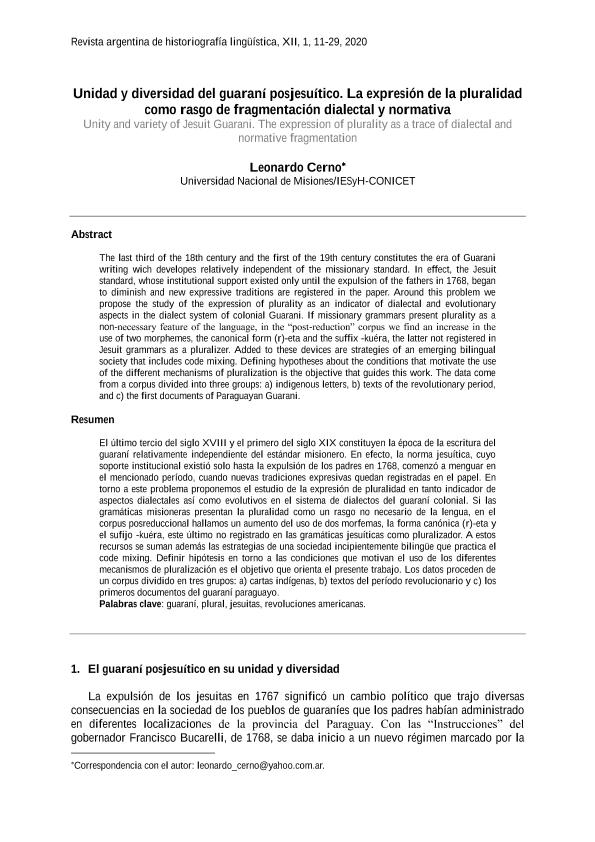Artículo
El último tercio del siglo XVIII y el primero del siglo XIX constituyen la época de la escritura del guaraní relativamente independiente del estándar misionero. En efecto, la norma jesuítica, cuyo soporte institucional existió solo hasta la expulsión de los padres en 1768, comenzó a menguar en el mencionado período, cuando nuevas tradiciones expresivas quedan registradas en el papel. En torno a este problema proponemos el estudio de la expresión de pluralidad en tanto indicador de aspectos dialectales así como evolutivos en el sistema de dialectos del guaraní colonial. Si las gramáticas misioneras presentan la pluralidad como un rasgo no necesario de la lengua, en el corpus posreduccional hallamos un aumento del uso de dos morfemas, la forma canónica (r)-eta y el sufijo -kuéra, este último no registrado en las gramáticas jesuíticas como pluralizador. A estos recursos se suman además las estrategias de una sociedad incipientemente bilingüe que practica el code mixing. Definir hipótesis en torno a las condiciones que motivan el uso de los diferentes mecanismos de pluralización es el objetivo que orienta el presente trabajo. Los datos proceden de un corpus dividido en tres grupos: a) cartas indígenas, b) textos del período revolucionario y c) los primeros documentos del guaraní paraguayo. The last third of the 18th century and the first of the 19th century constitutes the era of Guarani writing wich developes relatively independent of the missionary standard. In effect, the Jesuit standard, whose institutional support existed only until the expulsion of the fathers in 1768, began to diminish and new expressive traditions are registered in the paper. Around this problem we propose the study of the expression of plurality as an indicator of dialectal and evolutionary aspects in the dialect system of colonial Guarani. If missionary grammars present plurality as a non-necessary feature of the language, in the “post-reduction” corpus we find an increase in the use of two morphemes, the canonical form (r)-eta and the suffix -kuéra, the latter not registered in Jesuit grammars as a pluralizer. Added to these devices are strategies of an emerging bilingual society that includes code mixing. Defining hypotheses about the conditions that motivate the use of the different mechanisms of pluralization is the objective that guides this work. The data come from a corpus divided into three groups: a) indigenous letters, b) texts of the revolutionary period, and c) the first documents of Paraguayan Guarani.
Unidad y diversidad del guaraní jesuítico. La expresión de la pluralidad como rasgo de fragmentación dialectal y normativa
Título:
Unity and variety of Jesuit Guarani: The expression of plurality as a trace of dialectal and normative fragmentation
Fecha de publicación:
12/2020
Editorial:
Universidad de Buenos Aires. Facultad de Filosofía y Letras
Revista:
Revista Argentina de Historiografia Linguistica
ISSN:
1852-1495
Idioma:
Español
Tipo de recurso:
Artículo publicado
Clasificación temática:
Resumen
Palabras clave:
guaraní
,
plural
,
jesuitas
,
revoluciones americanas
Archivos asociados
Licencia
Identificadores
Colecciones
Articulos(IESYH)
Articulos de INST. DE ESTUDIOS SOCIALES Y HUMANOS
Articulos de INST. DE ESTUDIOS SOCIALES Y HUMANOS
Citación
Cerno, Leonardo Aurelio; Unidad y diversidad del guaraní jesuítico. La expresión de la pluralidad como rasgo de fragmentación dialectal y normativa; Universidad de Buenos Aires. Facultad de Filosofía y Letras; Revista Argentina de Historiografia Linguistica; 12; 1; 12-2020; 11-29
Compartir




